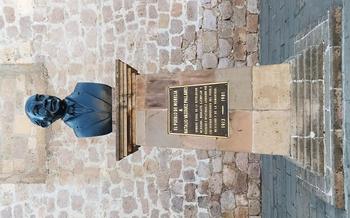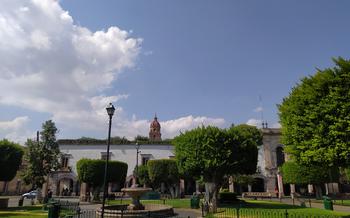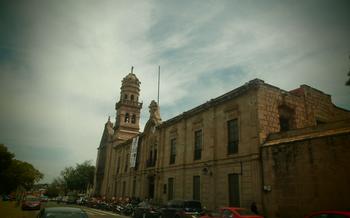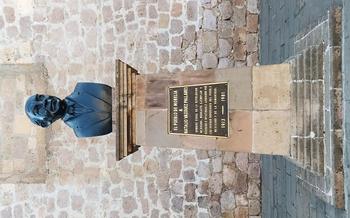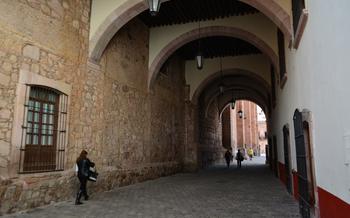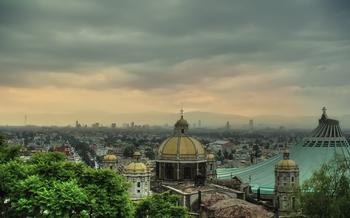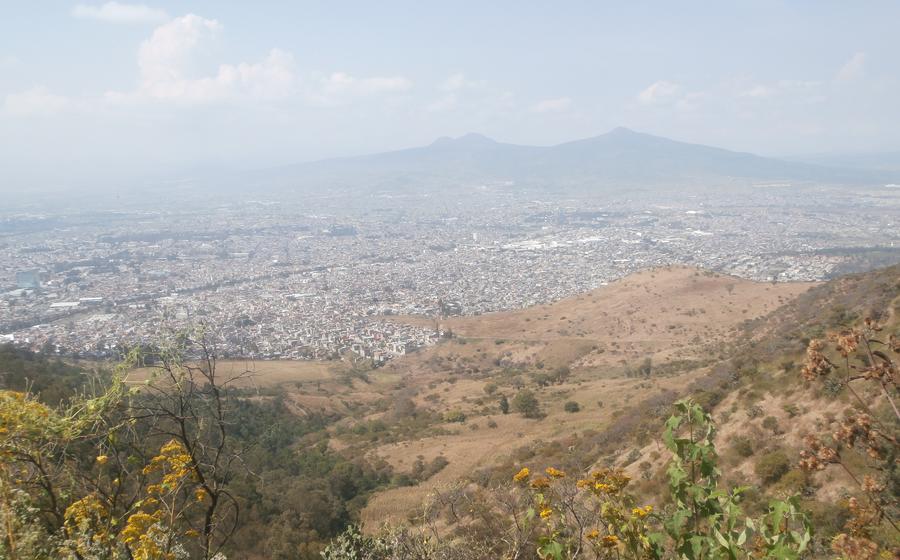
Cerro de Punhuato
- Historical Significance
- Natural Beauty
- Religious Bedeutung
- Cultural Heritage
- Outdoor Activities
- Historical Landmarks
- Local Cuisine
- Art and Culture
- Accommodation
- Transportation
- Safety
- Budget Tips
- Accessibility
- Photography Tips
- Insider Tip: Unveiling the Secret Cave of Cerro de Punhuato
Historical Significance
The Cerro de Punhuato holds a prominent place in the annals of Mexican history. Its pre-Columbian origins can be traced back to the Purépecha civilization, who revered the hill as a sacred site. During the Spanish conquest, the hill became a strategic vantage point, leading to the founding of the city of Morelia in 154Throughout history, the Cerro de Punhuato has witnessed significant events and played a role in the lives of notable figures, including the revolutionary leader José María Morelos y Pavón. It is also shrouded in legends and folklore, adding to its mystique and allure.
Natural Beauty
The Cerro de Punhuato stands out for its unique geological features and rock formations, a result of volcanic activity and erosion over millions of years. These formations create a diverse and captivating landscape, with towering cliffs, deep canyons, and hidden caves waiting to be explored.
The hill is also home to a rich variety of flora and fauna, including many endemic species found nowhere else in the world. Among the notable plant species are the oyamel fir, the Mexican weeping pine, and the Montezuma cypress, which create a verdant tapestry across the slopes. The fauna is equally diverse, with species such as the black-throated magpie, the rufous-capped warbler, and the white-throated jay adding their songs to the symphony of nature.
From the summit of the Cerro de Punhuato, visitors are rewarded with panoramic views of the city of Morelia and the surrounding countryside. The city's colonial architecture, nestled in a valley surrounded by rolling hills, creates a picturesque vista that is sure to leave a lasting impression. The hill's strategic location also makes it an ideal spot for outdoor activities and nature appreciation, offering a variety of trails for hiking, mountain biking, and rock climbing.
Religious Bedeutung
The Cerro de Punhuato holds a special place in the hearts of Mexican Catholics as it is home to the Sanctuary of Our Lady of Guadalupe. This iconic figure, known as the Virgin of Guadalupe, is deeply revered in Mexican culture and is considered the patron saint of the country. According to legend, the Virgin appeared to a humble peasant named Juan Diego on the hill in 1531, leaving her image imprinted on his tilma, or cloak. This miraculous event led to the conversion of many indigenous people to Christianity and solidified the Virgin's status as a beloved symbol of faith and national identity.
Every year, millions of pilgrims flock to the sanctuary to pay homage to the Virgin and seek her blessings. The most significant pilgrimage takes place on December 12, the feast day of Our Lady of Guadalupe, when the streets of Morelia and the surrounding area are filled with a sea of devoted pilgrims. The sanctuary hosts various religious festivals and events throughout the year, offering visitors a chance to immerse themselves in the vibrant expressions of Mexican Catholic faith and culture.
Cultural Heritage
The Cerro de Punhuato is a treasure trove of cultural heritage, reflecting the fusion of pre-Columbian and colonial influences. Archaeological excavations have unearthed ancient artifacts and ruins, shedding light on the region's rich pre-Columbian past. Visitors can explore these archaeological sites, gaining insights into the civilizations that once thrived here.
The hill is also home to a number of colonial-era churches and haciendas, showcasing the region's architectural heritage. These structures, often built from local materials, blend seamlessly into the natural surroundings, creating a harmonious fusion of nature and history.
In the surrounding villages, traditional crafts and workshops continue to thrive, preserving the region's cultural traditions. Visitors can witness skilled artisans creating intricate pottery, textiles, and other handicrafts, using techniques passed down through generations. These villages offer a glimpse into the living traditions and customs of the local communities, providing a deeper understanding of the region's cultural heritage.
Outdoor Activities
The Cerro de Punhuato offers a range of outdoor activities for adventure enthusiasts and nature lovers alike. Hiking trails of varying difficulty levels wind through the picturesque landscape, allowing visitors to explore the hill's unique geological formations, diverse flora and fauna, and breathtaking panoramic views. Mountain biking enthusiasts can enjoy challenging trails that traverse rugged terrain and offer exhilarating descents.
For those seeking a more adrenaline-pumping experience, rock climbing and rappelling opportunities abound on the hill's sheer rock faces. Experienced climbers can tackle challenging routes, while beginners can learn the ropes with the help of local guides. Camping and picnicking spots nestled amidst the natural beauty of the hill provide a tranquil retreat for those seeking a relaxing escape.
Wildlife enthusiasts can embark on guided nature walks to spot endemic species, such as the Michoacán wolf, and observe the diverse birdlife that calls the Cerro de Punhuato home. Birdwatching enthusiasts can delight in the opportunity to spot migratory species and rare birds of prey soaring above the hill's peaks.
Historical Landmarks
The Cerro de Punhuato is a treasure trove of historical landmarks that offer a glimpse into the region's rich past. One of the most significant sites is the Fuerte de San Pedro, a Spanish fort built in the 18th century to protect the city from attacks. Although only ruins remain today, the fort's imposing walls and strategic location stand as a testament to its former strength.
Throughout the hill, historical markers and plaques commemorate important events and figures associated with the Cerro de Punhuato. These markers provide a fascinating narrative of the hill's history, from its pre-Columbian origins to its role in the Mexican Revolution.
Visitors can also find statues and monuments dedicated to prominent individuals who played a crucial role in the region's development. These monuments honor their contributions and serve as a reminder of the rich cultural and historical heritage of the Cerro de Punhuato.
To delve deeper into the history of the region, visitors can visit the Museo Regional de Michoacán, located at the foot of the hill. This museum houses a collection of artifacts, documents, and exhibits that showcase the cultural and historical significance of the Cerro de Punhuato and the surrounding area.
Local Cuisine
The Cerro de Punhuato offers a delectable culinary experience, showcasing the traditional flavors of Mexico and the region's unique specialties. Visitors can savor authentic dishes prepared with fresh, local ingredients, reflecting the rich culinary heritage of the area. From traditional Mexican staples to regional delicacies, there's something to satisfy every palate.
For a taste of local cuisine, head to the restaurants and food stalls nestled amidst the charming cobblestone streets. Indulge in mouthwatering tacos, enchiladas, and pozole, each bursting with vibrant flavors and textures. Sample the region's specialty, the "carnitas estilo Michoacán," slow-cooked pork that melts in your mouth, accompanied by fresh tortillas and a zesty salsa.
Cooking enthusiasts can immerse themselves in the local culinary traditions by taking cooking classes or workshops. Learn the art of preparing traditional dishes, using authentic ingredients and techniques. Discover the secrets of making the perfect tamales, salsas, and moles, and take home a newfound appreciation for Mexican cuisine.
Don't miss the opportunity to explore the local markets, where vendors display an array of fresh produce, artisanal cheeses, and traditional sweets. Engage with the friendly locals, sample exotic fruits, and uncover hidden culinary gems.
Whether you're a foodie seeking authentic flavors or simply looking for a delicious meal, the Cerro de Punhuato offers a culinary journey that will tantalize your taste buds and leave you craving for more.
Art and Culture
The Cerro de Punhuato is not just a natural and historical wonder; it's also a significant cultural hub. Visitors can explore art galleries and studios showcasing the works of talented local artists. The surrounding villages are renowned for their traditional music and dance performances, which are a feast for the senses. Attend one of these vibrant performances to experience the region's rich cultural heritage firsthand. Throughout the year, various festivals and cultural events celebrate the region's unique identity. These events provide a fantastic opportunity for travelers to immerse themselves in the local customs and traditions. Engage with the friendly locals, learn about their way of life, and make memories that will last a lifetime.
Accommodation
The Cerro de Punhuato and its surroundings offer a range of accommodation options to suit every preference and budget. From cozy guesthouses and boutique hotels to charming vacation rentals, visitors can choose the perfect place to rest and recharge after a day of exploring.
For those seeking a truly authentic experience, staying in one of the traditional villages nestled at the foot of the hill is highly recommended. Visitors can immerse themselves in the local culture, enjoy delicious home-cooked meals, and experience the warmth and hospitality of the community.
To find the best deals and avoid disappointment, booking your accommodation in advance, especially during peak season, is advisable. Online platforms, travel agents, and local tourism offices can assist you in finding the perfect place to stay.
Here are some tips for finding unique and authentic accommodations:
- Look for small, family-run guesthouses or bed and breakfasts that offer a more personalized experience.
- Consider staying in a traditional hacienda or quinta, which often boasts beautiful architecture and lush gardens.
- Explore local websites and social media groups to find hidden gems and off-the-beaten-path accommodations.
- Don't be afraid to ask locals for recommendations; they can often point you towards unique and authentic places to stay.
Transportation
Getting to the Cerro de Punhuato is relatively easy from Morelia. There are several options for transportation, depending on your budget and preferences.
Public transportation is a convenient and affordable option. Buses depart from the Morelia bus station and take about an hour to reach the Cerro de Punhuato. You can also take a taxi, which is a bit more expensive but faster. The journey takes about 30-40 minutes.
If you prefer a more organized and hassle-free experience, you can book a private tour. Several tour operators in Morelia offer day trips to the Cerro de Punhuato. These tours typically include transportation, a guided tour of the hill, and lunch.
Once you arrive at the Cerro de Punhuato, you can explore the area on foot. There are several hiking trails of varying difficulty levels. You can also rent a mountain bike from one of the local shops.
Here are some tips for navigating the local transportation system:
- Buses in Morelia are generally reliable and affordable. However, they can be crowded during peak hours.
- Taxis are readily available in Morelia. Be sure to agree on a price before getting in the taxi.
- If you are driving your own car, be aware that the roads in the area can be narrow and winding.
No matter how you choose to get to the Cerro de Punhuato, you are sure to have a memorable experience.
Safety
When exploring the Cerro de Punhuato, it is essential to prioritize your safety and well-being. The area is generally safe for visitors, but it is always advisable to exercise caution and common sense. Here are some safety tips to keep in mind:
-
Be aware of your surroundings: Pay attention to your surroundings and be mindful of people and activities around you. Avoid walking alone in isolated areas, especially at night.
-
Stay on marked trails: When hiking or mountain biking, stick to designated trails to minimize the risk of getting lost or encountering dangerous terrain.
-
Inform someone about your plans: Let a friend, family member, or hotel staff know your itinerary and expected return time. This way, someone can raise the alarm if you don't return as planned.
-
Carry essential items: Bring a fully charged phone, a map or GPS device, a flashlight, and a first-aid kit in case of emergencies.
-
Respect local customs: Be respectful of local customs and traditions. Dress appropriately, ask permission before taking photos of people, and avoid engaging in any activities that may be considered offensive or disrespectful.
-
In case of emergency: If you encounter an emergency, dial 911 or the local emergency number. There are also emergency contact numbers displayed at various points throughout the Cerro de Punhuato.
Budget Tips
Exploring the Cerro de Punhuato and Morelia on a budget is possible with a bit of planning and savvy. Here are some tips to help you save money during your trip:
-
Transportation: Take advantage of the affordable and efficient public transportation system. The local buses and taxis offer convenient and budget-friendly options for getting around. Consider purchasing a Morelia Bus Card for unlimited rides at a discounted rate. Renting a bicycle is another great way to explore the city and the surrounding areas at a low cost.
-
Accommodation: Opt for budget-friendly guesthouses, hostels, or vacation rentals instead of expensive hotels. Look for accommodations in the historic center of Morelia, where you can find charming and affordable options within walking distance of many attractions.
-
Food: Indulge in delicious and budget-friendly Mexican cuisine at local markets, street stalls, and fondas (small, family-run restaurants). Sample fresh produce, traditional dishes, and tasty snacks at a fraction of the cost of tourist restaurants.
-
Activities: Take advantage of the many free or low-cost activities available. Visit the city's museums, which often offer free admission on certain days or have discounted rates. Explore the beautiful parks and gardens, such as the Parque Benito Juárez or the Jardín de las Rosas, which offer serene and free outdoor spaces for relaxation and exploration.
Accessibility
The Cerro de Punhuato is committed to ensuring that all visitors, regardless of their abilities, can enjoy its natural and cultural treasures. Wheelchair-accessible trails and facilities have been developed to accommodate visitors with disabilities. These trails provide a safe and enjoyable way to explore the hill's diverse ecosystems and stunning vistas.
When planning your trip, it is advisable to research accessible transportation options and inform your accommodation provider about your specific needs. Additionally, several tour operators offer accessible tours and activities tailored to the requirements of visitors with disabilities.
Remember to bring any necessary medical equipment or medications with you, as access to healthcare facilities on the hill may be limited. It is also essential to plan your activities according to your physical capabilities and endurance.
For further assistance, you can contact the Cerro de Punhuato Visitor Center, where friendly and knowledgeable staff will be happy to provide information and support. They can recommend accessible routes, suggest suitable activities, and connect you with local organizations that can provide additional assistance.
By embracing accessibility, the Cerro de Punhuato strives to create an inclusive environment where everyone can experience the beauty and wonder of this natural and cultural landmark.
Photography Tips
The Cerro de Punhuato offers endless opportunities for stunning photography. Whether you're capturing the natural beauty of the landscape, the historical landmarks, or the religious sites, there are a few tips to help you take amazing photos.
Plan for the best light: The golden hours of sunrise and sunset provide the most flattering light for photography. Aim to arrive at the Cerro de Punhuato early in the morning or late in the afternoon to capture the best light for your shots.
Use a tripod: A tripod is essential for capturing sharp and steady photos, especially when shooting in low-light conditions. It will help you avoid camera shake and ensure your photos are perfectly focused.
Experiment with different perspectives: Don't just stick to shooting from eye level. Try climbing to a higher vantage point, getting down low, or using a wide-angle lens to capture unique and interesting perspectives.
Include people in your shots: People add life and scale to your photos. Include hikers, pilgrims, or local residents in your shots to create a sense of place and convey the human connection to the Cerro de Punhuato.
Be patient: Sometimes the best photos come from waiting for the right moment. Be patient and observant, and you may be rewarded with a magical shot that captures the essence of the Cerro de Punhuato.
Insider Tip: Unveiling the Secret Cave of Cerro de Punhuato
Beyond the well-trodden paths of Cerro de Punhuato lies a hidden gem waiting to be discovered – the secret cave known as Cueva Encantada. This mystical grotto, adorned with sparkling crystals and ancient rock formations, offers a glimpse into the hidden wonders of the hill. To find this hidden treasure, follow the trail that leads to the Sanctuary of Our Lady of Guadalupe. Just before reaching the sanctuary, look for a discreet opening nestled among the rocks. With a flashlight in hand, venture into the darkness, and you will be rewarded with a breathtaking spectacle of subterranean beauty. Experience the thrill of spelunking and immerse yourself in the enchanting atmosphere of this secret cave, a true hidden gem of Cerro de Punhuato.

